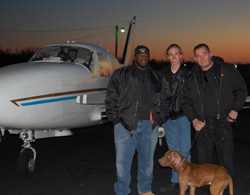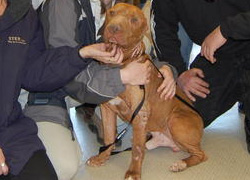 G, far left, and Joe, far right, stand with a volunteer pilot and the pit bull they brought from Kentucky to Long Island. The pit bull had serious injuries and was likely used as a “bait dog” to train fighting dogs.
G, far left, and Joe, far right, stand with a volunteer pilot and the pit bull they brought from Kentucky to Long Island. The pit bull had serious injuries and was likely used as a “bait dog” to train fighting dogs.
What has two wings, four paws, and a dozen tattoos? A new series on the National Geographic Channel has the answer.
“Rescue Ink Unleashed” follows Rescue Ink, “a rag-tag group of bikers, tattoo fanatics and street guys, who came together in 2007 with the common goal of ending animal abuse,” according to the show’s Web site. The episode “Bad Reputation,” scheduled to air Friday, Oct. 16, tracks the rescue of a pit bull and the dog’s journey from Kentucky to Long Island, N.Y., by air.
Animal Rescue Flights (ARF), an organization that coordinates air transportation for animals from overcrowded shelters, where they would likely be killed, to parts of the country where families are waiting to adopt them, assisted Rescue Ink in the transportation of the dog by general aviation.
Series stars Joseph Panzarella and George Perry, known as Joe Panz and G, flew along with ARF volunteer pilots to pick up the dog, nicknamed “Ribbon” for his tattered ears; he was later renamed Rebel. Found with serious injuries after a suspected dog-fighting ring was broken up, Rebel was likely bound and used as a “bait dog” to train fighting dogs.
Julia Ryan, ARF co-founder and pilot of one of the flights in the relay that brought Rebel to Long Island, said about 500 pilots volunteer for ARF flights and the organization coordinates flights every weekend. But this one was a little different.
First, pilots for ARF flights don’t typically take along human passengers. “The Rescue Ink guys and cameraman wanted to go along and capture video in Kentucky, (and) we had to fly both ways,” she said. “… On top of that, these guys are 250 to 300 pounds in tank tops and tattoos”—not the typical animal shelter worker.
“Great guys though. Really great guys.”
The out-and-back trip took a full day, with volunteer pilots flying four legs; ARF coordinates flights so that animals can be taken on journeys of hundreds of miles. Joe and G, along with a National Geographic cameraman, Rebel, and the pilot, climbed into a Piper Aztec in Kentucky for the long trip home and arrived after dark after stopping and switching aircraft. Ryan, who was the flight coordinator for the rescue, followed their progress on FlightAware.
 Ribbon, seen here before going to the airport, poses for a picture with her foster caretakers
Ribbon, seen here before going to the airport, poses for a picture with her foster caretakers
“It was sunrise to beyond sunset,” Ryan said.
Rescue Ink brought Rebel back to their clubhouse and made him the mascot of the group—a spirited animal with a rough past and scars, and what the Rescue Ink Web site calls “a shining example of the remarkable ability of animals to forgive and live in the moment.”
The flight to be featured on Oct. 16 was the first time Rescue Ink and ARF worked together, and Ryan said the organizations have worked together since. ARF tries to educate people about spaying and neutering their pets and to eliminate the need for rescue flights, she said. But until then, pilots are volunteering their time to help save animals like Rebel.


